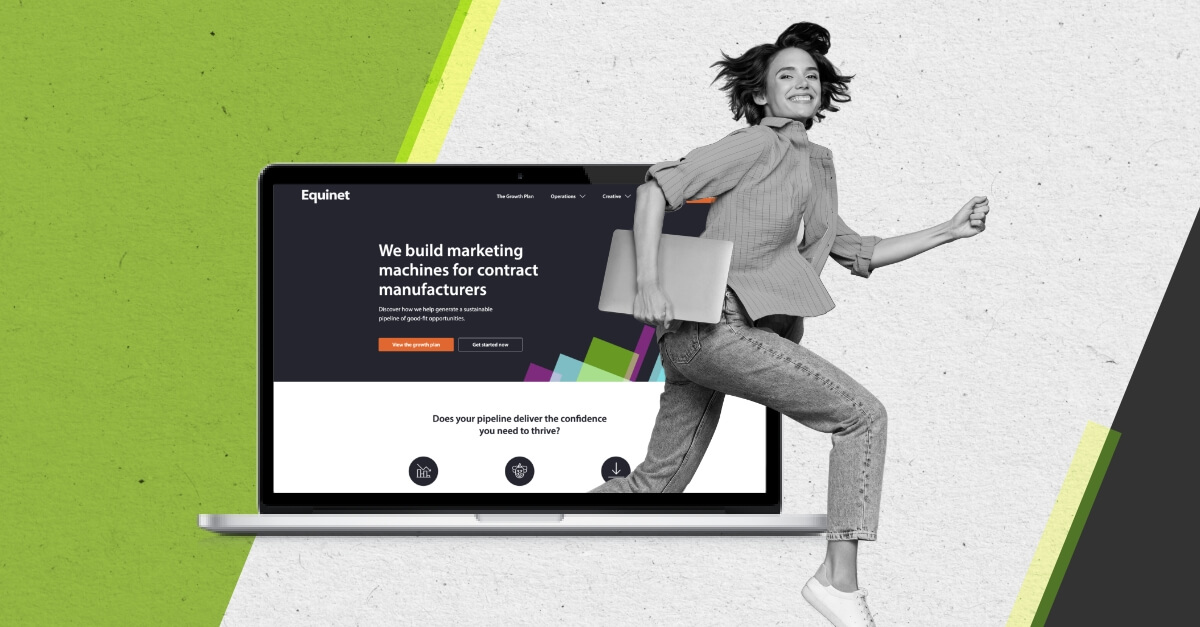
This post covers the nine best practices to ensure you have an effective B2B website that attracts and converts your buyers.
Just how important is an effective website?
No business can afford to be without a website; it is a fundamental building block of building a business.
But your website does not stand alone; it is fighting for a prospect’s attention against all your competitors. And with buyers having limited browsing time, you need to remember that it also competes with other sites – industry media, bloggers, peer-to-peer sites, social media and even entertainment sites. Your site has to hold its own in this battleground – and because of this, it may not be good enough to be better than your competitors; your website needs to stand out against all the background noise.
The importance of developing the best website you possibly can, cannot be overstated. Your website must win the battle for attention and then hold that attention. And it then needs to go on to convince and convert to bring in the maximum revenue for the business.
Today’s buyers are researching before even approaching a company to enquire. They contact a vendor only when they are nearly 60% of the way through the decision process. The implications here are obvious, your content needs to show up in that research, and your content needs to shine.
When buyers approach you directly, they will likely know exactly what they are looking for in a solution and will have very specific questions they want to be answered comprehensively and honestly by your website or a salesperson. (Implies that your salesperson will need to be more of a knowledgeable consultant).
During their research, they will consult various sources across many channels to get a general overview of the industry’s possible solutions to their problems. Once they have narrowed down potential solutions, they will start researching vendors. At this stage, your website will be the primary source of information about your organisation and its range of solutions.
(Remember, though, that it won’t be the only source – buyers will consult peers and industry media to verify the integrity of your claims, your position within your market and your past performance as regards deliverability, reliability, customer service and support.)
Bottom line? Your website needs to be the best it can be. Here are nine best practices to focus on.
1. Have a clear strategy and direction for the site
One of the main issues with a poor website is a lack of direction, which results in a confusing and disconnected site. This is an issue for human visitors and those all-important search engines. Having a clear strategy for the site is essential.
Starting with a clear business strategy, you must plan the website around the business's goals and marketing plan. Before you even start developing a site, you need to be clear about your brand identity, your brand positioning, your product offerings, your sales process; you're after-sales service and so on. You can’t just make these things up as you go along – you need to be crystal clear on what they are before you plan your website.
Assuming your business strategy is sound and understood, then the first step is a website brief which sets out the performance goals you wish to achieve.
The second half of this strategy relies on an understanding of your target audience. You cannot develop a successful website without a comprehensive understanding of that audience. If you haven’t gone through the process of identifying your typical potential buyers as part of your business or marketing strategy, then you need to do this now, creating a set of buyer personas.
The results of this stage should be a global site strategy and a pillar page strategy which lay out how you will be engaging and influencing visitors to attain your business goals.
Knowing where you are going and how to get there is the foundation of a successful website. A confused approach will lead to a confused website and to confused buyers that will simply leave – fast – and go on to visit the next site on their vendor list.
2. Communicate your value proposition(s)
Marketing is about answering the question, “What’s in it for me?” Why should someone buy your product or service? What is the benefit to them?
A website is no different – the fundamental questions you need to answer from the moment a visitor lands on a page on your site are:
- Why should I stay on this site?
- What can this site do for me?
The first thing a visitor needs to see on any page of your site is a benefit statement – something that lays out a value proposition and answers those two questions.
Do you know what the benefits are to your target audience? What would they value?
Once again, we see the value of understanding your target audience and the importance of those well-researched buyer personas. Understanding your audience will lead to understanding what they value and what they would see as a benefit.
Remember that your site may have different types of relevant visitors, which could include:
- The main buyer
- Their assistant doing the legwork or conducting initial research
- A financial gatekeeper
- A director who might have to approve any buying decision
- A blogger who might be reviewing or writing about your company and its offerings
- An existing customer looking for support (and hopefully heading towards a repeat purchase or a recommendation to a peer)
- A technical expert working with the buyer
All these different visitors must see benefit statements that relate to them. This is likely to require different pages targeting those visitors.
You want to be able to tell a different story to each of them. You want to guide them through the site in a way that tells that story. And you want to address any issues they have along the way.
Understanding each of these different types of visitors is paramount. You need to know what they are searching for, what their motivations are and what pain they face in their daily working lives.
This understanding will allow you to tailor benefit statements about solutions that answer the question, “How will this help me in my current situation?”
3. Take care of credentials and branding
One of the key factors influencing a purchase is trust. Does the buyer consider you a reputable company with authority, a reliable track record, and one they can trust?
This is where branding and the value of that brand are essential. If you have a recognised brand that stands for something in customers’ minds (brand perception), you should leverage that. And even if you’re a new brand, strong branding is still important in brand-building.
Often overlooked is the importance of clear, consistent and strong branding on every page. Looking again at the questions you must answer, the relevant one is, “Whose site is this?” Once you get deep into many websites, the page branding becomes diluted. A visitor who lands on that page directly from a search engine may struggle to identify who the company is – resulting in a lost opportunity as they click away.
Arguably, the first websites were simple credential presentations – who are we, and what do we do? This is still important and relevant. No matter how famous or well-known your brand is, there will still be people who do not know who you are or all you do and, more importantly, what you stand for. This is your opportunity to tell your story, to lay out all your brand values and build that all-important brand perception.
Yet another buyer’s question is, “Are they any good?” Content such as case studies and customer endorsements can be powerful ways to answer this, along with blogs that establish authority and other relevant credentials.
4. Appropriate calls to action
"What do you want me to do – how can I take this further?" A clear call to action should be presented to the visitor. This should not happen at the opening of the page, as you won’t have explained the proposition and sold the solution, so it will be pointless. You might only get one opportunity to ask for a response – so you shouldn’t waste it.
It is also very annoying to be presented with a call to action before you have even looked at the page. Many sites do this with a pop-up that interferes with the presentation of the proposition. Do this, and your visitor will most likely leave.
At the end of the page, there should be a clear and powerful call to action – it should be obvious what the next step is and what you are asking the visitor to do.
In many cases, this would offer a piece of premium content, such as an eBook, research results or a white paper, which can be downloaded in exchange for contact details and permission to do a follow-up.
5. Develop relevant content
"How can you help with my research towards a solution?" Helpful content that answers questions provides an overview, or explains technical details is valuable and attractive. As is content that explains the issues, lays out the benefits and pitfalls of various approaches or offers a strategic viewpoint.
The more helpful you can be during the buyer’s research phase, the more likely you are to figure in their shortlist when it comes time to buy.
6. Prioritise mobile-first design
If your website is not mobile-friendly, you shoot yourself in the foot. As of June 2022, nearly 60% of website traffic comes from mobile devices.
Even if none of your visitors uses a mobile device to browse your site, search engines such as Google will look at how friendly your site is towards mobile devices and rank you accordingly. In fact, since 2016, Google has worked based on mobile first when indexing websites.
Still not convinced? Let’s take a look at some more stats:
- 80% of B2B buyers use mobile devices at work (Boston Consulting Group)
- 61% of users say they move on to another site if they can't find answers immediately on a mobile site (Think With Google)
- 57% of users don't recommend a business with a poorly designed or no mobile site (Formstack)
- Over 60% of B2B buyers report that mobile has a significant effect on a recent purchase (Boston Consulting Group)
Note that these statistics have been trending steadily upward over the past few years, so if your site isn’t mobile-friendly, you will be losing significant business now and even more in the future.
7. Ensure your site is SEO friendly
Since 2011, around nine out of every ten buyers have started their research with an online search. If you are not showing up in that search, you will not even be in the game.
There’s not much more to say on this; search engines are the gatekeepers to your website, and you need to do everything you can to rank with them. Implementing SEO best practice throughout your site is an absolute given.
8. Don’t forget the basics and clear navigation
Many businesses seem to focus so much on the deep issues of their website development project that they often miss out on the basics. It is often surprising how hard you must search on some B2B sites just to find a phone number, for example.
Don’t believe me? Well, according to a report from KoMarketing:
- When asked what causes them to leave a vendor website, 44% of survey respondents indicated “No Contact Information / Phone Number.”
- When asked to rate website elements that annoy them, more than half (54%) of respondents indicated that the lack of thorough contact information reduced a vendor’s credibility and thus would cause them to leave a website.
- When asked what content assets were missing on most company websites, 51% of respondents again indicated “Thorough Contact Information (phone/email/address).”
So if you do nothing else, answer the following questions.
How do I contact this company?
When it comes time to buy, many buyers may prefer to pick up the phone and talk to a human, so make sure your phone number is visible on every page. Don’t make them work for it. Some visitors may not need to read to the end where the call to action is, so having a phone number or email address above the fold will help capture these people
Both phone number and address are essential – mainly if your services are location dependent. Buyers will want to know where you are. They may wish to visit you, or maybe they’d like to check out your operation; they might have logistics concerns or concerns about their green footprint if you are too far from them.
A contact email address for general enquiries (rather than a call to action) is also crucial for vendors who want to get in touch directly or have a specific question they can’t find the answer to on the website.
How do I find...?
Most visitors will be searching for something, even if they have used the search engine to land on a specific page of your website. Search engines are fallible, and that web page may not contain the exact information they were looking for, or they may have a supplementary or follow-up question. Ensure you have a suitable search mechanism on your site and that the search box is easy to find and use.
Where am I?
As mentioned, many visitors may arrive on a page deep in your site if they have come from a search engine. It is important that they instantly see what part of your site they are on – the subject or topic of that page. Check every page has a title or clear signposting that lets the visitor know where they are within the site.
Where do I go from here?
A clear website structure and a self-evident navigation scheme are non-negotiable. Visitors should be in no doubt of their options when choosing where to go next on the site. Links should be so clear that users do not have to think, and what they represent should again be obvious.
More than this, you need to emphasise the links you want visitors to take while not limiting their options. They should be entirely free to go where they want, but at the same time, you need to ensure that some potential choices are more attractive.
9. Plan for growth – grow to a plan
The thing to remember about a website is that, unlike most other forms of marketing, it does not have to be complete from day one. Trying to create a perfect website in one hit is a direct route to failure.
You must even rid yourself of the notion that websites can be complete. That they can be built and then forgotten about for a few years. This usually happens because a business has invested so much time and money in developing the perfect website they run out of budget and resources.
The fact is that search engines like to see fresh content, and so do visitors. A blog which continuously publishes new posts can help with this.
But more than this, circumstances change, markets change, and your visitor’s needs change – so continuously improving your website should be a natural part of doing business.
If you are developing a new website, you want results as soon as possible. Waiting a year while the website is ‘finished’ is illogical when a launch pad website can be built quickly and effectively.
This more efficient website development process is known as Growth Driven Design. You start with a quick-win launch pad website and build from there through ongoing continuous improvement cycles.
This process naturally implements many of the points we have covered in this post – strategy, branding, value proposition, call to action, content and structure.
Conclusion
Developing a website can be a costly, involved, lengthy, exhausting and ultimately ineffective process. The very nature of trying to create a huge site that does everything almost dooms any development to failure.
Following the first eight points here will ensure your site is effective, and the ninth is the method to establish an effective website with the minimum of resources and budget; in the shortest possible time.




